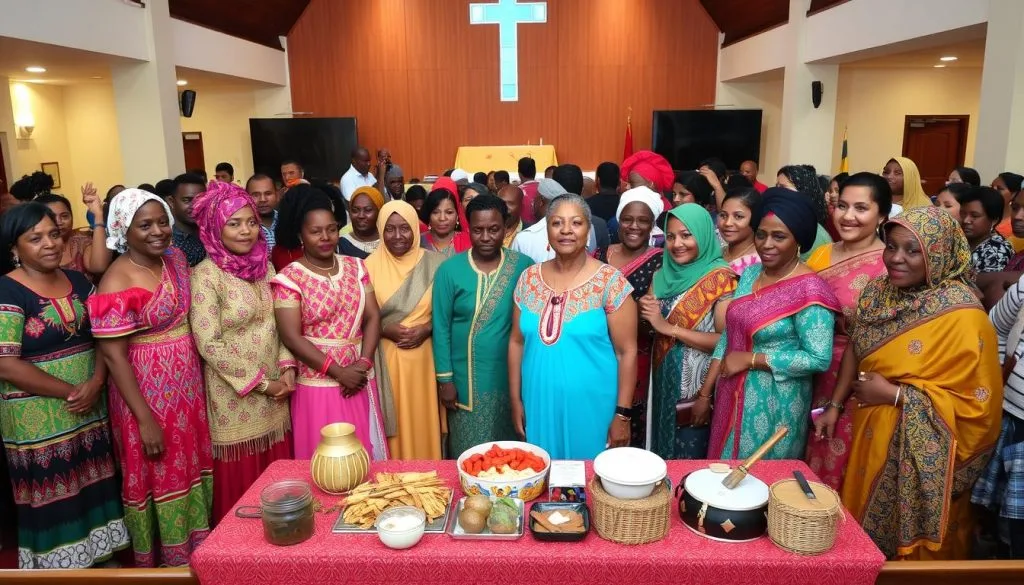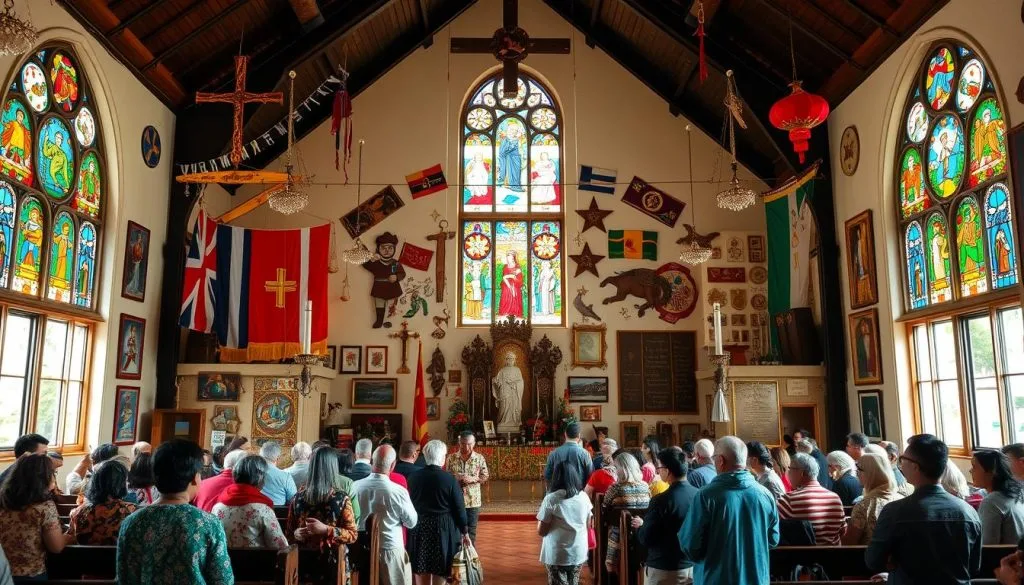First Community Church is in a lively, multicultural area. It’s always been a place where everyone feels welcome. But, as the neighborhood changed, the church leaders knew they had to update their programs.
Pastor Emily believes in unity through diversity. She thinks it’s not just right, but it also makes the church stronger. “Our church is a mosaic of people from all walks of life,” she said. “We have a duty to make sure everyone feels seen, heard, and valued.”
First Community Church started a journey to add cultural diversity to their programs. They wanted a place where everyone could feel at home and grow in faith together. This article will look at their strategies, challenges, and the positive changes they saw.
Key Takeaways
- Incorporating cultural diversity in church programs can strengthen the faith community and promote inclusivity.
- Strategies include integrating multilingual services, celebrating diverse cultural holidays, and providing culturally competent training for staff and volunteers.
- Engaging the local community, highlighting diverse voices in worship, and continuously evaluating program effectiveness are critical for sustained success.
- Resources such as books, articles, workshops, and conferences can support churches in their diversity and inclusion efforts.
- Embracing cultural diversity requires a genuine commitment to creating an environment where everyone feels welcomed, valued, and empowered to share their unique perspectives and experiences.
Understanding Cultural Diversity in Churches
In today’s world, churches have a chance to celebrate the rich cultural mix of their members. Cultural diversity includes the unique traits, traditions, and backgrounds of different groups. It’s a key part of modern faith communities.
What is Cultural Diversity?
Cultural diversity in churches shows up in many ways, like ethnicity, language, and religious practices. It’s about the diverse cultural and social identities that shape church members’ experiences. By recognizing and valuing these differences, churches can become more inclusive and welcoming.
Why Cultural Diversity Matters
It’s crucial for churches to embrace cross-cultural outreach and embracing diversity in faith communities. When churches celebrate their members’ unique cultural identities, they create a sense of belonging. This helps break down barriers and promotes unity.
- Enhances community engagement by providing a platform for diverse voices and perspectives to be heard and valued.
- Fosters inclusivity, ensuring that all members feel welcomed, respected, and able to fully participate in church activities and worship.
- Enriches the spiritual and social experiences of congregants by exposing them to new traditions, customs, and ways of expressing faith.
By embracing cultural diversity, churches can become vibrant and dynamic. They reflect the diversity of their local and global contexts. This helps them connect with and serve their congregants better.
“When we embrace cultural diversity, we open our hearts and minds to a richer, more fulfilling faith experience.”
Benefits of Embracing Cultural Diversity
Churches gain a lot by welcoming different cultures. They become places where everyone feels at home. This unity is built on culturally responsive church programs and cultural traditions in worship.
Enhancing Community Engagement
A church that values diversity sees more people getting involved. People from all walks of life feel they belong. This leads to more people attending, helping out, and giving back.
This active participation helps the church make a real difference. It touches the lives of its members and the wider community.
Fostering Inclusivity
Churches that celebrate their members’ cultures create a warm space. Everyone feels respected and included. This sense of belonging is deep and real.
It lets people fully join in and grow spiritually. They can share their unique perspectives and traditions.
“Embracing cultural diversity in our church has been a transformative experience. It has opened our eyes to the richness of different faith traditions and brought our community closer together.” – Pastor Emily, Cornerstone Church

Welcoming cultural diversity brings many benefits. It boosts community involvement and fosters inclusivity. Churches become vibrant and dynamic places. They truly show the beauty of God’s creation.
Assessing Your Church’s Current Cultural Diversity
Understanding your church’s cultural diversity is key to creating an inclusive space. By looking at your congregation’s demographics and listening to feedback, you can learn a lot. This knowledge helps you work towards diverse leadership and intercultural dialogue in your church.
Evaluating Demographics
Examine your church’s congregation closely. Collect data on race, ethnicity, language, age, and socioeconomic status. This info helps you spot where diversity is lacking and where to focus your efforts.
Gathering Feedback from Congregation
Engage with your congregation to learn about their experiences. Use surveys, focus groups, or one-on-one talks to gather feedback. This feedback is crucial for creating inclusive programs and initiatives.
| Demographic Factors | Current Representation | Desired Representation |
|---|---|---|
| Race | 60% White, 30% Black, 10% Hispanic | 40% White, 40% Black, 20% Hispanic |
| Ethnicity | 70% European, 20% African, 10% Asian | 50% European, 30% African, 20% Asian |
| Language | 90% English, 10% Spanish | 80% English, 20% Spanish |
| Age | 65% 50+, 25% 30-49, 10% 18-29 | 50% 50+, 30% 30-49, 20% 18-29 |
| Socioeconomic Status | 75% Middle Class, 15% Upper Class, 10% Lower Class | 60% Middle Class, 20% Upper Class, 20% Lower Class |
By deeply assessing your church’s diversity and listening to your congregation, you can spot areas for growth. This knowledge helps you build a more inclusive and welcoming space for everyone.
Creating Inclusive Church Programs
Churches are working hard to be more welcoming to everyone. They’re using services in many languages and celebrating different holidays. This makes everyone feel included and valued.
Integrating Multi-Language Services
Churches are now offering services in many languages. This helps everyone understand and feel part of the community. It shows they really care about everyone’s background.
Celebrating Cultural Holidays
Churches are also celebrating different holidays and traditions. They hold festivals, have cultural performances, and share traditional foods and music. This makes everyone feel their culture is important and valued.
| Multicultural Holiday Celebration Ideas | Benefits |
|---|---|
|
|
Churches are making big strides in being inclusive. They’re celebrating the rich diversity of their community. This creates a welcoming space that reflects the values of incorporating cultural diversity in church programs and multicultural ministry.
Training Staff and Volunteers
Creating a culturally responsive church program is more than just wanting to help. It takes hard work to teach and prepare the people who make these programs work. By focusing on their cultural understanding, churches can start to bridge gaps between different cultures through faith.
Importance of Cultural Competency
Cultural competency means knowing and valuing different cultures. For church staff and volunteers, this skill is key. It helps ensure everyone feels welcome and valued. When they understand cultural differences, they can better meet the needs of all people, creating a place of respect and understanding.
Strategies for Effective Training
- Comprehensive Onboarding: Start by teaching cultural competency to new staff and volunteers. This helps them think inclusively from the beginning.
- Ongoing Education: Keep the team informed with regular training. This includes learning about new cultural trends and how to be more inclusive.
- Experiential Learning: Give staff and volunteers chances to experience different cultures. This could be by attending cultural events or taking language classes.
- Mentorship and Coaching: Match new team members with experienced mentors. They can offer guidance and support in understanding cultural differences.
- Resource Library: Create a library of books, articles, and videos on cultural diversity and inclusion. This helps everyone stay informed and grow in their understanding.
By focusing on cultural competency training, churches can empower their teams. This makes them champions of programs that celebrate diversity, strengthening the faith community.
| Training Approach | Key Benefits |
|---|---|
| Comprehensive Onboarding | Establishes an inclusive mindset from the start |
| Ongoing Education | Keeps team updated on emerging cultural trends and best practices |
| Experiential Learning | Fosters cross-cultural understanding and appreciation |
| Mentorship and Coaching | Provides personalized guidance and support |
| Resource Library | Offers a wealth of information on cultural diversity and inclusive practices |

“Embracing cultural diversity is not just a box to check – it’s a transformative journey that strengthens the very fabric of our faith community.” – Rev. Emily Johnson, Senior Pastor
Engaging the Local Community
Churches need to connect with the local community to embrace cultural diversity. They can do this by working with diverse groups and creating special outreach programs. This way, churches can welcome people from different cultures, making everyone feel included and valued.
Partnerships with Diverse Organizations
Churches can reach more people by teaming up with local groups that serve different cultures. These partnerships can help host events together, share resources, and plan activities. This collaboration can help everyone understand and appreciate each other’s cultures better.
- Look for local groups that help specific cultural communities, like immigrant support, language schools, or cultural arts centers.
- Start talking to these groups to see if you can work together. Focus on what you both value and want to achieve.
- Work together on events, workshops, or volunteer projects that bring people from different cultures together.
Outreach Programs for Various Cultures
Churches can make their community feel welcome by creating special programs for different cultures. These might include services in different languages, cultural celebrations, or workshops. These programs help share and celebrate the traditions and customs of various cultures.
- Find out who lives in your community and what cultures they come from.
- Make programs that meet the needs and interests of these cultures, like worship services in different languages or cultural events.
- Work with community leaders and experts to make sure your programs are real and meaningful.
- Spread the word about these programs through social media, community newsletters, and ads.
By reaching out to the community and working with diverse groups, churches can create a lively, welcoming place. This place celebrates the diversity of cultures and helps everyone feel at home, no matter where they come from.
“Diversity is not about how we differ. Diversity is about embracing one another’s uniqueness.” – Ola Joseph
Highlighting Diverse Voices in Worship
In today’s diverse faith communities, celebrating cultural traditions in worship is key. Embracing diversity makes worship more inclusive and engaging for everyone. By showcasing the voices of people from different backgrounds, churches can create a welcoming space for all.
Inclusive Music and Art
Music and art are great ways to show cultural diversity. Think about using hymns, songs, and performances that reflect your congregation’s musical traditions. Also, show artwork and sculptures that celebrate the diverse cultural heritage of your faith community.
Sermons that Reflect Diversity
The content of your sermons is also important for embracing diversity. Ask your clergy to use experiences and perspectives from different cultures in their messages. This makes everyone feel seen, heard, and valued, no matter their background.
| Strategies for Inclusive Worship | Benefits |
|---|---|
| Incorporate diverse music and art | Celebrates cultural traditions and fosters a sense of belonging |
| Deliver sermons that reflect diversity | Ensures that all members of the congregation feel represented |
| Encourage participation from diverse community members | Empowers diverse voices and promotes active engagement |
By embracing diversity in worship, churches can become vibrant and inclusive. They celebrate cultural traditions and empower all members to feel valued and heard.
Evaluating Program Effectiveness
It’s important to check how well cultural diversity programs work. Churches can improve by listening to what people say after events. This helps make sure programs meet the needs of everyone in the church.
Gathering Feedback Post-Event
Getting feedback right after events is a key step. Churches can use surveys, focus groups, or talks to hear what people think. This helps understand what’s good and what can be better.
Continuous Improvement Strategies
- Look at feedback to find ways to get better, like improving programs or marketing.
- Have a group of people from different backgrounds give advice on future plans.
- Keep an eye on who’s in the church and what they need to stay included.
- Work with other groups to share ideas and learn from their experiences.
By always trying to get better, churches can make their programs more effective. This helps build stronger connections among people from different backgrounds.
| Feedback Mechanism | Key Insights Gathered | Frequency of Use |
|---|---|---|
| Post-Event Surveys | Participant satisfaction, program strengths, areas for improvement | After each major event |
| Focus Groups | In-depth perspectives on cultural relevance, engagement, and inclusivity | Quarterly |
| One-on-One Conversations | Personalized feedback and suggestions from diverse congregants | Ongoing |
By always checking how well programs work and making changes, churches can improve. This helps with intercultural dialogue in religious settings and meets the changing needs of a culturally diverse congregation.
Resources for Further Learning
Exploring cultural diversity in churches can be very rewarding. It can change how we see and interact with others. We’ve gathered some great resources to help you learn more and put these ideas into action.
Books and Articles on Cultural Diversity
Looking for a deeper understanding of cultural diversity in churches? Check out “Multicultural Ministry Handbook” by David A. Anderson and “Embracing Diversity: How to Understand and Reach People from Other Cultures” by Soong-Chan Rah. These books offer valuable insights and practical tips for creating welcoming spaces.
Workshops and Conferences to Attend
Going to workshops and conferences is a great way to meet others, learn from experts, and get hands-on experience. Look into the “Multicultural Church Conference” by the Evangelical Free Church of America or the “Diverse Leadership Summit” by the National Association of Evangelicals.
